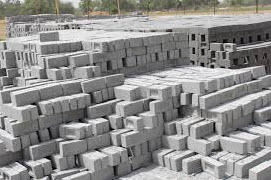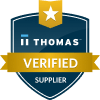Refractories are important to high temperature manufacturing for their thermal insulation properties and are commonly used to protect personnel and equipment. They are critical to industries such as glass, ceramic, and metallurgy. In general, refractories are used for temperatures in excess of 2,000°F, for applications such as the melting of glass or metal, or the curing of ceramic wares.
Alumina (neutral) and magnesite (chemically basic) represent two common ingredients used in the production of refractories, which involves a mixing step which is critical to the quality and cost of the final product. Mixing is critical because raw materials can be vastly different in physical characteristics, such as particle size (from powdery to 1/4” granular) and bulk density (35 pcf for graphite to 100+ pcf for minerals).
For castable refractories, the mixing cycle first goes through a dry mixing phase where all solid raw materials are homogenized. The dry mixing phase may be followed by water addition and an ensuing wet mixing phase. To facilitate mixing, it is best to go through dry mixing of powdery and granular ingredients before adding liquids. This is because inter-particle attraction is generally lower with dry materials, making it easier for them to mingle.
Modern best practice suggests mixing be accomplished at the highest practical intensity to maximize production rate. High intensity means using high mixing tool speeds during both dry and wet mixing–provided wear, ventilation and other issues are acceptable. One of the advantages of high-intensity mixing is a shorter overall mixing time. In general, the same degree of mix quality can be achieved in ¼ of the time if the tool speed is doubled. A typical batch mix cycle for castables should be approximately 4 minutes, including material charge and batch discharge time with minimal residue after discharge.
Incomplete or deficient mixing can lead to premature failure of the refractory. Only a decade or two ago, a typical glass tank needed to be relined every 8-10 years. The efforts and downtime are extensive for such an exercise. With properly mixed and better quality refractories installed, many glass producers now go through a cold shut down every 15-20+ years, reaping substantial savings. Such advances are attributed to improvements in formulation, including mixing, in the manufacture of refractories.
A Lancaster Products K-Series Mixer can impart custom-designed levels of mixing intensity, varying tool speeds at will through the use of VFD control. The intensity range typically covers one order of magnitude, or roughly 1-10, however ranges as high as 1-100 are also possible. This wide range of intensity is more than adequate to handle any refractory applications for very short cycle times. Compared with other types of mixers, the flexibility to vary the mixing intensity input represents one of the advantages a counter-current, rotating pan mixer has over other types of mixers which have limited latitude in intensity adjustment.
Contact us today to discuss how a Lancaster Mixer can satisfy you refractory mixing requirements.
717-273-2111


